The RACES of Exodus
While the majority of the creatures on Exodus have a logical biological system, there are some races who do not have “blood” in the normal sense at all. Instead, a more magical, etheric substance sustains them. These races are known as “Sangui’ji” or magic-blooded and live very differently from the normal races. Also, not everyone who begins life as one race always stays that way. The “Blighted” are those who are afflicted by what are often called ‘curses’ that have altered their physical bodies in impossible ways.
BLOODED RACES
HUMAN - WILDKIN - KOGG - URUL - AMIRAN - NOM - LIV’RI / OLUSANGUI’JI
D’JINN - FAE - SCIOS - GOLEMSBLIGHTED
WEREBEASTS - AKKAD’AI - NETRA-ZAZANTA - THE FELLWildkin
Wildkin are a beastial shapeshifting species that share traits with both humans and animals. They rule over Jiran, having established territories all across the region, and live lifestyles that echo their dual heritage. A wildkin is born in their natural beast form, and overtime learns to shift into a more humanoid state. The main Wildkin species divided by mammalian, reptilian, arthropodic, avian, and aquatic clades and each have had a significant impact on the land.
Most wildkin live nomadic lives and do not often form anchored cities. They prefer to live among beasts of their kind, and nearly every wildkin clan has a totem ancestor that they draw power from. Their weapons and armor are formed from sturdy bones and Nydid weave (Nydid is an organic plant-like material that grows and changes structure to adapt to it’s host), and occasionally imbue elemental crystals into their gear. While they face harsh discrimination in Shadarrin and Baldeming (often treated like lesser people), in Jiran Wildkin reign supreme.
And everything else is prey.
A FORM IN FLUX (Morphology)
While wildkin appear to shift between either a more humanoid or more beast shape, their bodies are actually always subtly shifting. Claws and fangs grow and shrink, the skeleton restructures to support quadripedal or bipedal movement, ears subtly shift between man and beast. These things happen subconsciously for wildkin, the same way a human’s pupils dilate and hair stands up. Wildkin cannot cast spells, but it is theorized that their bodies naturally use magic in various ways, such as compensating for the mass loss when shapeshifting.
In their human-shape, wildkin’s head, legs, and arms generally resemble a human’s proportions. They sacrifice size, strength, senses and form to gain various advantageous societal traits such as a voicebox, increased dexterity from human hands and feet, more stamina, and the ability to use equipment that wouldn’t otherwise be viable for them. This form is considered more “socially acceptable” in cities and allows wildkin to form better social connections with other races.
Their natural state shares more in common with beasts then man. Everything but the torso and arms match their token animal, but with altered porportions that facilitate something inbetween bipedal and quadripedalism. In their natural form they can communicate with beasts of their kind (such as an bird wildkin being able to communicate with avian beasts). They can mate with other wildkin within similar classes (mammalian wildkin can mate with other mammals – reptiles with reptiles ) but rarely produce offspring with other races. Halfkin humans have traits of parent’s physiology but cannot shapeshift.
AVATARS OF THE WILD (Culture)
Descended from the ancient Kymeer, wildkin are said to have originated on Jiran and there is an abundance of evidence to support that theory. While all beings are instinctively connected to nature, Wildkin seem to have special bonds with their ecosystems. They naturally understand the needs of the planet’s animals, dedicating themselves to the preservation of all creatures that share their like. While there is often animosity between carnivorous and herbivorous wildkin, both have a deep respect for one another and the circle of life.
Wildkin in their natural habitats rarely revert to their humanoid form. They see little need for it if not to interact with other races. This is also important as a wildkin that spends too much time in their human form has trouble controlling their instincts when they revert to their natural shape. While they cannot cast spells and do not bother with the intricacies of magic, Wildkin are able to manipulate enchantments in weapons and armor. Additionally, many wildkin employ ashé paint to enhance their natural abilities with their prana.
Long ago the Saurops (reptilekin) ruled over Jiran, rending most of the land as swamps and keeping other creatures at bay with poison mists. Overtime many of the other clades came together to overthrow the Saurops’ rule, creating a united wildkin kingdom in eastern Jiran. Currently the Felini (feline wildkin) clade rule at the top of the kingdom, and saurops are all but outlawed.
Wildkin who cater more to their human form are generally looked down on among their peers, especially with those who cannot control their instincts in their beast form. While many carniverous wildkin look down on humans and nom as prey, they tend to have positive relations with most other races, but have a strong dislike for the amiran who hunt them. Hunting wildkin for servants is a very lucrative business, and most wildkin in Shadarrin and Baldeming are descended from those who were taken captive from their homeland and brought across the world.
FROM CUB TO ALPHA (Creating a Wildkin)
1) What class(species) of wildkin are you?
Mammal – Reptile – Fish – Bird – Arthropod
- You gain +2 to 2 stats depending on your animal species as well as different biological abilities (ex: flight, burrowing, night vision, agility, water breathing)
- Shifting adds +2 to all stats but reduces KNO by 4. Cannot use normal weapons or communicate with words.
2) How were you raised?
Where do you live? Were you raised in the homeland of Jiran, or somewhere else? Do you prefer your human form or natural state? Do you have a pack or family? If not, what happened to them? Have you or anyone you known ever been hunted? (You may be entitled to compensation, dial 1-800…)
3) Wildkin Tools & Weaponry
Wildkin generally prefer to fight with their teeth, claws, and other natural weapons. As a result, swords are uncommon in favor of wrist/ankle blades. Some wear elaborate bone armor stitched with Nydid – a biological material that grows with its host and develops natural defensive adaptions to their environment. Bone weapons passed down through generations often carry the prana of their ancestors, granting surprising abilities to the descendant. Wildkin also use ashé brands to enhance their abilities (such as allowing a lizard wildkin to shoot their spikes or have scales of diamond) and imbue elemental crystals into their gear.
Common Items:
Wrist/Ankle blades(mammals), chakrams, slings,
boomerangs & javelins, tail clubs/blades (reptiles)
Examples of ashé brand effects:
An Aves(bird wildkin) wings
being bladed and able to shoot feathers. A Felini (feline wildkin)
with a roar that deflects projectiles. A Lupo (wolf) pack sharing
a brand that makes them stronger and faster the more they are near
eachother. A shark with lasers..
Liv'ri-Olu
The Liv’ri and the Olu are plant and fungal species respectively. While they share many similarities and are often confused for one another, they are not the same race. The Liv’ri are the guardians and cultivators of Exodus’s plantlife, growing seeds out of their very hair to spread forests across the world. The Olu, subterranian fungal decomposers, are feared and hated across the world for their revelry in death and decay.
Liv’ri are a passive people and prefer to cultivate and grow. As a result, they excel in the healing arts and grow the most nutritious food in all the world. Liv’ri communities are often secluded paradises that previous few people are blessed to discover. The Olu are more aggressive and invasive by nature. They utilize mind-control to encourage wars among other races and collect the corpses for necromantic purposes. Not all Olu are evil, and unlike the "dirty” necromancy of other races, their magic usually has very beneficial effects for setting the stage for new life to grow where death once was.
SYSNTHESIS & NECROSIS (Morphology)
Both Liv’ri and Olu have similar biological compositions, despite their bodies working very differently from eachother. On the surface, both have fey features, with sharp eyes, chins, and ears. They grow plant & fungal foliage from anywhere that a human would grow hair, while the hair on their head often produces consumable fruits, seeds, and spores. They both are capable of producing vine-like extensions from their hair, wrists, and ankles and begin to more closely resemble plants and fungi as they get older. Liv’ri and Olu can live up to 100,000 years, though few ever make it that far, and true “adulthood” is around 300 years of age.
The sunkissed Liv’ri can, but do not have to eat to maintain photosynthesis. Almost all Liv’ri are capable of surviving off water and sunlight alone. Similar to plants, most Liv’ri are androgynous, though some do posess definitive sexes. As they grow, the seeds in their hair mature and fall out, creating new forests throughout their lifetime. (Occasionally, in the right conditions, some of these seeds will produce offspring.) After a certain age, Liv’ri feel a natural compulsion to travel and spread their forests across the world, eventually settling in a single location to form a sanctuary.
The bioluminsescent Olu feast on the dead, which tends to leave a terrible first impression. As decomposers, Olu break down corpses and return the energy into the atmosphere for trees and plants to turn into ether. The Olu are naturally able to use their fungal abilities to turn a dead body into nutrients, but can also use their spores to affect living organisms. They naturally emit mind-bending pheromones that connect them with a host’s brain to cause illusions or send mental suggestions. The more a host has injested an Olu’s spores, the more control the Olu has over them.
A LIFE OF LIFE & DEATH (Culture)
Liv’ri are some of the most beloved races across Exodus for their friendly and peaceful nature. They often get along with nearly all other races, especially wildkin and fae, but have a particular dislike towards humans, urul, kogg, and nom for how destructive their buildings can be. Urul especially enjoy raiding Liv’ri sanctuaries, having little trouble eventually tearing through their defenses with persistant aggression. For this reasion, liv’ri are often born into separate Cultivator and Defender castes. There are no known liv’ri sanctuaries in shadarrin outside of a couple districts. Liv’ri magic is almost entirely plant-based, though they have been known to occasionally learn spells outside of their natural field.
The Olu are derogatively called “Rotsuckers” for their natural attraction to the dead. Since the majority of their communities live underground, they are far more familiar with kogg, nom, and Earth-based scios than any of the surface-dwelling races. They prefer to live beneath large surface communities where death is plentiful and food is abundant, though they have no problem subsisting off of dead plant matter and do not actively hunt and kill their prey. Instead, they use subterfuge and intrigue to start great conflicts among people. Nearly all olu can sense when someone is near death, and exhibit greater control over weaker targets. Though it takes a lot of energy and a bit of training, many olu can use a portion of their own lifeforce to revive the recently deceased.
While many liv’ri and olu communities do not get along, the few that do have some of the most successful societies all across Exodus.
GROW & FLOURISH (Creating a liv’ri/olu)
1) Are you floral or fungal?
What plants/fungi make up your composition? (Up to 3)
- Liv’ri gain bonuses to healing abilities & plant-based magic, Olu gain bonuses to lifestealing & ability to raise the recently dead as zombies.
- Abilities are based on whatever 3 combinations of plants/fungi make up your liv’ri/olu. (For example a cactus & rose liv’ri would have spikes. an aloe liv’ri is near fireproof. A yeast olu will get you drunk. You’re welcome.)
2) How were you raised?
Did you grow up in a community among your people? Was it a strict, xenophobic, and rigid structure or was there freedom to express? Are you naturally a cultivator or defender? Are you used to other races? What do you smell like, and are you poisonous? Have you created any woods in your journeys?
3) Liv’ri/Olu defenses.
Liv’ri are generally defensive people who fight using blades, whips, and chemicals. The vines that grow from their hands and feet give them incredible mobility across a battlefield, especially as trees and fungal caps grow around them. Nearby plants awaken to their call, with grass sharpening to blades and branches and roots swinging to obstruct their enemies. Cultivator liv’ri are not the most advanced combatants, but Guardians live for battle. Because of the dexterity of their prehensile vines, it isn’t uncommon to see a liv’ri swordsman fighting with four blades at once. Their natural healing abilities make them very hard to kill.
While many Olu prefer stealth, psychological warfare, and striking from shadows, the race as a whole have invented a powerful form of shield-based combat. Olu have created mushroom shields with various additional features such as elastic cords, blades, reactive spores and more. Olu wield these “shield-gauntlets” on both hands and generally prefer to engage in close-ranged combat so that their spores can infect and invade their opponent, allowing them to inflict psychoactive effects on their victims.
Human
Humans of exodus are the prime examples of adaption to any circumstances. They have managed to thrive on every continent and their customs and ideals often end up inflencing the other races that live alongside them. This adaptability is also prevailant in their mana, as humans tend to have the most versatile spells and have scholars in all four branches of magic. As a result, humans are some of the most populous race, and so it helps that their aesthetic tends to draw them favor wherever they go. Humans make great diplomats, especially when bridging divides among other races.
However humans are also some of the most resource-intensive people on Exodus, requiring large amounts of space and materials to build their empires. Preferring to worship their rich and ignore their poor, their vanity and lust for pleasure have created some of the largest societal divides of any race. This has led to a history of wars and chaos that have left scholars wondering if humans should be clasified as one of the monster races, along with the urul and amiran.
VARIABLE GENETICS (Halfbreeds)
While it is uncommon for most people of different races to create offspring (such as a wildkin pairing with an urul), humans are unique in that they are able to pair with any other race. Halfbreeds tend to be rejected by society and usually have a harder life. They often retain the ability to freely command magic, something which is rare among the people of Exodus(most races have a natural connection to the world that directs how their magic works ), but take on some of the physical traits of their nonhuman parent.
KINGDOMS IN ALL REGIONS (Culture)
Humans of Shaddarrin, Baldeming, and Jiran are all very different. They have invented a universal language called "The Common Tongue" and in their dealings with many other races have taught it to them. While Shadarrin and Baldeming often do not get along despite having many trading agreements, the humans of Jiran tend to live a more isolate life in-tune with the natural world.
Shadarrians have adapted to the harsh wasteland environment with iron and steam. In Shadarrin's steampunk society, every bladed weapon comes equipped with a projectile launcher and every launcher has a blade. Prosthetics are as common as injury and disease and are often armed with useful weapons or tools. External prosthetics are also used for everyday tasks, and slaves are very common. Shadarrians are divided between citizens of the districts and scavengers out in the wasteland. Humans are also most commonly affected by the cursed radiation that permeates the land, gaining physical mutations and strange abilities in the process. They are known as the Twisted.
Though Baldeming is a large continent, the vast majority of its humans live on the giant mountain that sits in the middle of the region. Mr Mauratnas is saturated with magic, which has empowed the humans there to turn it into a defensible living space with many extradimensional secrets. Runes are etched into every piece of furnature and weaved into each thread of clothing. Magic dominates everyday life, and everyone has potential to learn fantastic abilities. Despite this, power is not distributed equally and Baldeming is also divided. The humans live on the mountain by necessity, not by choice, as to travel into the surrounding lands is to die in countless ways.
The various human tribes in Jiran have learned to cooperate out of both honor and need of survival. Unlike on Shadarrin, they are not the most populous race and unlike Baldeming they do not have a singular defensible location to live in. Instead, many have found their own place in Jiran's circle of life as nomads. The sole exception to this is the kingdom of Kaalam, a thriving community ruled by two king brothers. This kingdom has secured its place with smart alliances and powerful warriors, becoming an important neutral location on the continent. Since Jiran is also the home of the largest amiran kingdoms, humans run the risk of being hunted everyday and taken in by the giants as pets.
SHINE YOUR EYES (Creating a human)
+ 1 to any stat. (Halfbreeds instead gain one trait from nonhuman parent's genetics)
1) Where were you born?
- Jiran - Tribal, Nydid weaponry & ashé brands (+2 DEX )
- Baldeming - Magical, fantasy archetyle (warrior, explorer, or mage?), enchanted gear. (+2 KNO)
- Shadarrin - Steampunk, technical gear and gunblades. (+2 CON)
2) How were you raised?
- Were you a noble in the districts of shadarrin & upper levels of baldeming?
- Were you a scavenger in the wastelands or native of the jungles?
- Are you a halfbreed with different race parents?
While Shadarrians humans frown on magic and Baldemians overindulge in it, the Jirani prefer to find balance between martial and magic.
- Shadarrin: Gunblades, Bladeguns, Grapplehooks, bombs & traps, prosthetic limbs
- Baldeming: Melee weapons & shields, crossbows, enchantments
- Jiran: Ashé tattoos, martial skill, animal companions, poisons
Urul & Urlin
The first word anyone would use to describe the Urul is "savage." These large, rowdy, powerful, tusked warriors are the threat that keeps villagers awake at night. Urul live for battle, and their entire society is developed around it. Respect is earned through conquest, and war is an everyday part of life. Urlin are the urul's diminutive, magic-wielding counterparts. They barely grow up to 3 feet tall and survive off of the strength of their numbers alone. Curiously, though not very intelligent on a whole, Urlin are drawn to magic and are capable of learning spellcasting.
There are many mysteries surrounding the origin of the urul, and many believe them to be originally spawned from the monsterous ogres that roam across Baldeming. There is evidence that shows urul are related to many of the cyclops, bugbears, and troll-like creatures on Exodus, further cementing their classification as one of the monster races. Despite this, not every urul is "evil," though their culture demands brutality, and some try to separate themselves from the reputation of their race.
BUILT FOR BATTLE (Anatomy)
Urul range from 6 to 8 ft tall, and weigh up to 800 lbs. They have extremely thick skin (ranging in earthy colors such as greens, browns, and reds), long arms, and dense muscle and bone, with many more layers of muscle than a human. Their bodies are often stocky, and it is extremely rare to see a skinny Urul. They have very pronounced tusks protruding from the lower jaw, which can open a full 120 degrees and a bite force that can easily sever limbs of smaller races. Urul are capable of consuming and digesting just about anything with little ill effects, and have been known to even consume bombs. When pushed to extreme emotion or the brink of death, Urul enter into a state of blind rage that they rarely can return from. In this state, their skin turns red and their strength triples, but once they calm down their hearts stop and they perish. Urul have a lower lifespan than humans, but reproduce quickly, and have been able to adapt to just about every environment.
Urlin are short and bony. They tend to live in crowded dens all across Exodus and are widely considered more of a pest species than a rational, respectable race. Their natural magical inclination combined with insatiable greed makes them vulnerable to posession by malevolent spirits. These posessed urlin become shamans and spiritual leaders for their people, guiding them towards the nefarious purposes of a higher power beyond themselves. Curiously, urlin ears and eyes are very valuable magical ingredients.
ARMED, ALWAYS (Culture)
Making it to adulthood is a profound achievement in urul culture, and surviving to 40 is legendary. Urul are forced to prove themselves from the moment they are born, and "love" is nowhere to be found in the definition of "family." Urul are taught that everyone and everything besides themselves is a tool to be used for their pleasure as long as they are strong enough to subdue all others. Respect is only given to power and fear, and every day is dedicated to training to grow stronger. The urul survive and thrive off of raiding other settlements and taking the supplies they need. Slaves are an important part of their culture since many urul are so dedicated to battle that they lack in many other vocations.
Urul's dedication to combat has invented some of the most creative and deadly weapons ever invented. Urul have a strong appreciation for fire, and their best blacksmiths can rival the finest Kogg. Their martial mastery has also produced some of the greatest fighters on the face of Exodus, though these particular urul have learned the importance of patience and discipline. 1 in every 500 urul are born "cursed" with a conscious and can see how warped the values of their peers are, they rarely survive. Every few centuries, urul all across Exodus are known to burst into a sycronized rage, rampaging and attacking everything in sight as a collective army for several days until their hearts stop. This calamity is equivalent to an extinction event, and has led to massive shifts in the world's history. Nobody understands the cause of this, but smaller instances of similar syncronized urul clan rampages do happen more frequently.
Little is known about Urlin life. The goblinoid people seem to have little ambition besides the most base necessities of life. One particular quirk is their addiction to magic and dogged pursuit of any and all shiny items. Urlin often set traps or sneak into settlements to steal anything they find valuable. This has led them to create and scatter chests of stolen loot all across Exodus, often hiding them behind an unwitting guardian or series of trips.
GROWING POWER (Creating an urul)
+3 to STR +2 to CON, -1 to CHA & KNO
1) STATS
- STR doubles when enraged (+1 each turn you are hit). CON drops by 1 every turn when enraged.
- Most people don't like you.
- ADVANTAGE on Intimidation checks, DISADVANTAGE on Charm.
- Can eat anything and bite through bone.
- When near death, enter rage. If enraged for too long (or sustain too much fatal damage), you perish when your rage ends.
2) How were you raised?
-
Were you raised in a customary urul clan, focused on combat and war? Have you ever raided a
village before and do you own any servants? Are you a chief or related to one, and do you have
morals? Are you used to civilization, and how do others outside of your race treat you?
Are you educated? If so, who taught you?
3) Urul Tools & Weaponry
-
Urul are very fond of chains and heavy weapons, so it isn't uncommon to see an urul utilizing what
someone would consider a greatsword swining on the end of a long spiked chain. Masters of melee
combat, urul can be found using a wide variety of weapons and even some exotic inventions completely
unique to them. Besides chains, what sets urul apart are their weaponized armor, often utilizing
fire, acid, and explosives in various compartments of their equipment. Urul are very fond of bombs,
and will even go so far as to swallow bombs for surprise attacks. Because of their ability to store
things in their body without taking damage, some urul even spit knives at their opponents.
Common Weapons: Chains, Greatswords, Greatclubs, War gauntlets, tower shields (specialized "biting" shields), spiked armor, slings, javelins, bombs... so many bombs.
Common urul "spit" attacks: Acid, Rocks, Knives/Swords, Magma, Fire, specialized insects, more bombs.
Nom
Standing tall at a foot and a half, the nom are one of the smallest people to ever build some of the largest empires on Exodus. Subterranean by nature, many nom do not often come into contact with the surface dwelling races, and thus few have seen the fantastic, technologically advanced societies born from nom culture. The nom have blended magic and sciences in a way no one else could even imagine, but their books are so complex and encrypted that their culture is surrounded by mystery.
And the nom prefer it that way.
DESIGN < FUNCTION
Your average nom usually stands between one and two feet tall. Their dark, pearly eyes are adapted for the lightless underground, but function well under sunlight (it isn't uncommon to see nom wearing light-dimming spectacles in the daytime), and sometimes posess sets of smaller secondary eyes. They have large pointed ears and their noses can range from very prominent to mostly nostrils. Some nom grow catlike fur, especially when living on the surface. Their hair tends to grow in spiky clumps and they have a fondness for conical hats that shape their hair. Their most impressive adaptation is their disproportionately large, powerful brains. Nom process, retain, and relay information faster than any other creature on Exodus. Nom tend to live to be around the same age as humans, but their scientific nature can sometimes dramatically shorten or extend their lives.
GENIUS = PERSPECTIVE
The nom live in a mathematically dominated society that values education above all. Nom struggle to appreciate things unless they can discover how it works and what its function is. To the nom, life and everything in it is a puzzle to be solved. Everything must be broken down to its fundamental parts and understood intrinsically. Their mathematical perspective has even influenced their religious beliefs; they search for infinity with division and multiplication, knowing that everything can become infinitely smaller or infinitely larger. They see patterns in all things, and many believe that some sort of consciousness has coded the laws of matter, time, and space.
SOCIETY ÷ MAGNEGAUNTLET
In nom society everyone builds upon eachother's discoveries, thus it is deeply shameful to hoarde information. The highest praise goes to those who's inventions progress nom quality of life without doing damage to the planet. So far, the invention of the magnegauntlet represents the pinnacle of nom brilliance. The magnegauntlet is an aggregation of microscopic cubes controlled by magnetic runes formed onto a glove that every individual nom posesses. The magnegauntlet can absorb minerals and break them down into usable their elementary particles to make more cubes that the nom can use. The magnegauntlet interfaces directly with the nom's nervous system, acting as an extension of its body and is used for everything from travel to building construction to self defense. This technology has allowed nom to create entire moving citadels that can shapeshift to suit the needs of every individual citizen.
CREATING A NOM
STATS - Nom gain +6 to KNO and lose -2 to STR & -2 to CON. Advantage on ANALYZE checks.
TOOLS - your Magnegauntlet has 3 configurations: COMBAT, SHELTER, and TRAVEL
What do its three forms look like? (Weapon can act as a summon, costs energy to maintain.
TRAVEL can either be a land, sea, or air vehicle).
HISTORY - Were you raised in a nom society or elsewhere? Are you from:
- Shadarrin (Understanding tech and mechanics)
- Baldeming (understanding magic and magitech)
- Jiran (Understanding psycology and biomechanics)
Kogg
A race of beings well-grounded in Shardarrin, known to be the architects of some of the greatest creations in all of Exodus. Koggs have the ability to build anything that they have the the proper materials for. The quality of the craft depends on how much they believe in what they are creating, the cause behind it’s creation, and how well it aligns with their ideals (The better a kogg knows themself and what they want, the better their craftsmanship). Kogg build anything from homes and decor to machines and weapons, making them a welcome addition to any society.
The average kogg is about 4 ft tall, muscular, and stocky. They are highly durable and favor jagged heavy armor that can double as a weapon. Kogg are very strong and resilient, and a squadron of koggs is called a "crisis." These small wrecking balls of creativity have a unique, mysterious connection to the vibrations of everything in existence, they call this connection the "Frequensea."
THE FREQUENSEA
"The frequensea is everlasting and in tuned with Exodus." Most kogg are connected to the vibrations of the planet. Many warriors of the Kogg bend, twist, create, and destroy the land around them through their connection to the frequensea. This is done by producing waves to commune with the the frequensea through certain movements and breathing techniques. A kogg can manipulate anything with a frequency, though koggs that level of control is a very rare sight, as because koggs who have fully connected to the frequensea are honored as deitys an are separated from the rest of their people to do greater works.
There is no one head to the kogg community, unlike the districts of Shardarrin. Kogg are guided by a foundation that operates as a supportive base rather than a ruling party. The groups that are designated for such work are intertwined in the common citizens affairs to aid them in all cases. This creates an equal system that build connections and bonds from top to bottom of the hierarchy.
KOGG CLASSES
- * Adlˈyā: Highest class of koggs in nobility and leadership. Great actions through architecture can grant this ranking. Their creativity is highly valued to their culture, and they are the masterminds to the kingdoms of all Koggs.
- * Timbre: Well-studied in the cognition of the frequensea in most the most knowledgeable of the kogg society. Most times would be at the side of an Adlˈyā.
- * Locksmiths: Warlords of the battlefield, generals to their kingdom. The highest rank a kogg could ever reach in a military stand. Teaching and building a proper keychain. Lock smiths have ranks with in itself
- 1. Authority: 4th ranking
- 2. Orchestrator: 3rd ranking
- 3. Perusalor: 2nd ranking
- 4. Key-holder: 1st ranking
- * Resonants: The warriors of kogg empires, those called to do battle in times of war. Well connected to the frequensea, they use the earth in different ways depending on there role in a keychain (A 10-kogg squadron). Koggs that are considered resonants are lead by locksmiths which embody all the roles of a keychain.
- * Cords: Diplomats and couriers of kogg kingdoms. Koggs with this position are very good at traveling and communicating with other races as they spend their years learning and meeting other kingdoms, making them prefect for sending messages. Cords will always get their messages across, even if the messages is not received with open arms.
- * Ollz : Worker types of kogg nations well oriented in mining and construction of tunneling systems and piping. These koggs are the backbone of any of their empires.
- * Booster: A merchant of the kogg.
- * Kogg: The natural term for anyone who does not have a title if you so chose to step in the path of one of the titles.
Even if getting it across means coming to arms....
CREATING A KOGG
STATS - Kogg gain +2 STR, +1CON and gain a +3 Bonus to crafting.
WEAPONS - Kogg prefer weapons that can also act as instruments, favoring blunt large blunt weapons over blades, and having a particular mastery over hammers.
HISTORY - Were you raised among your people or elsewhere? What is your kogg class or your parents' classes?
Scios
"The lands of the scios are uninhabitable to any other creature. The elements are as alive as the people spawned from them. Even the animals are imbued with elemental properties; the birds fly on fire without burning. The fish dictate the flow of the currents. Very few outsiders have travelled to the ethereal scios kingdoms and returned to tell the tale."
THE ELEMENTALKIN (Overview)
Of all the people of Exodus, the scios are some of the most majestic. Humanoid elementals with transparent skin that naturally flow with the forces of nature that make up their bloodline, scios live very different life from most of the other races. They do not grow old, they can explore the harshest climates, and there is no limit to how powerful a scios can become. As a result it is easy for these powerful people to become corrupted by their strength and dominate over other races, but thankfully most scios value honor and cooperation over oppression.
... Most scios..
MAGMA FOR BLOOD, ICE FOR FLESH (Biology)
Beings made of elemental energy, Scios take on a wide range of shapes and sizes. While roughly humanoid in form, an elemental can have multiple arms, eyes, or even disconnected parts that oscilated around the main form. Scios's hair strands radiate their element, and their bodies are made of a combination solid, liquid, plasma and gaseous matter all related to their elemental lineage. Rather than organs, Scios have whats known as "cores." Two main cores where the heart and mind are, and several secondary cores scattered throughout their bodies. It is said that some of the most powerful Scios can regenerate off of only a single core thought most perish if either of their main cores are destroyed.
An earthborne scios might have flowing clay for blood, tightly pact grains of sand for skin, and precious stones where their organs would be. A fire scios could have transparent skin, with glowing plasma flowing beneath. It isn't uncommon for scios to show lineage from multiple different elements, such as a combination of water and air to make a Hurricane Scios. Rather than a single element, scios's bodies and titles often represent forces of nature. An iceborne elemetal could be a snowblade (mixed metal), dry ice (mix air), or avalanche (mix stone) scios. Even combinations that wouldn't be found on earth, such as a Crystalshock Scios, is possible.
VOICE OF THE STORM (Culture and Abilities)
Originating in Baldeming, Scios often live in elaborate societies related to their element, but a few clans are known to be migratory. They are natural terraformers, and they mold the landscape to suit their needs, often creating changes that can alter the entire ecosystem of an area. As a result, they have claimed territory in specific loations around exodus to build their kingdoms, rarely seeking to expand out of respect for the surrounding wildlife. Scios kingdoms are as varied as humans, but with a heavy emphasis on artistic expression and symbolism. Scios like to stand out from one another, and wear unique garments customized to their individual biologies. This creative expression can be seen in their towns and cities aswell, with each sporting a unique aesthetic and theme.
Scios have the ability to natually control magic relating to their element. Rather than elaborate spellcasting, a scios's abilities are naturally inspired and relate to their personality and heritage. Scios can fuse with one another both temporarily or permanently with a variety of different results and for a myriad of purposes, such as battle, mating, or sharing knowledge. Usually a core personality will control the main body while the "aura" of the second person remains in their thoughts and the shape of their shadow. Scios can fuse permanently aswell, with the more dominant personality taking over completely and gaining a massive increase to their own abilities aswell as traits of the absorbed. This is usually only done between family members or lovers, but some criminal scios have become "cannibals," addicted to the power gained from absorbing others.
CREATING SCIOS
Form: Which combination of elements make up your biology? (Up to 2) How many arms do you have? (How many heads? Do you have legs?)
History: What colors/shapes/objects/animals symbolize your personality or values? Were you raised among your people in one of the elemental kingdoms, part of a small nomadic clan, or have never met another scios?
Power: Which one or two aspects of nature do you draw power from? Fire(Light, Heat, Electricity) Water (Ice, Cloud, Vapor, Blood) Terra (Crystal, Stone, Glass) Air (... Air)
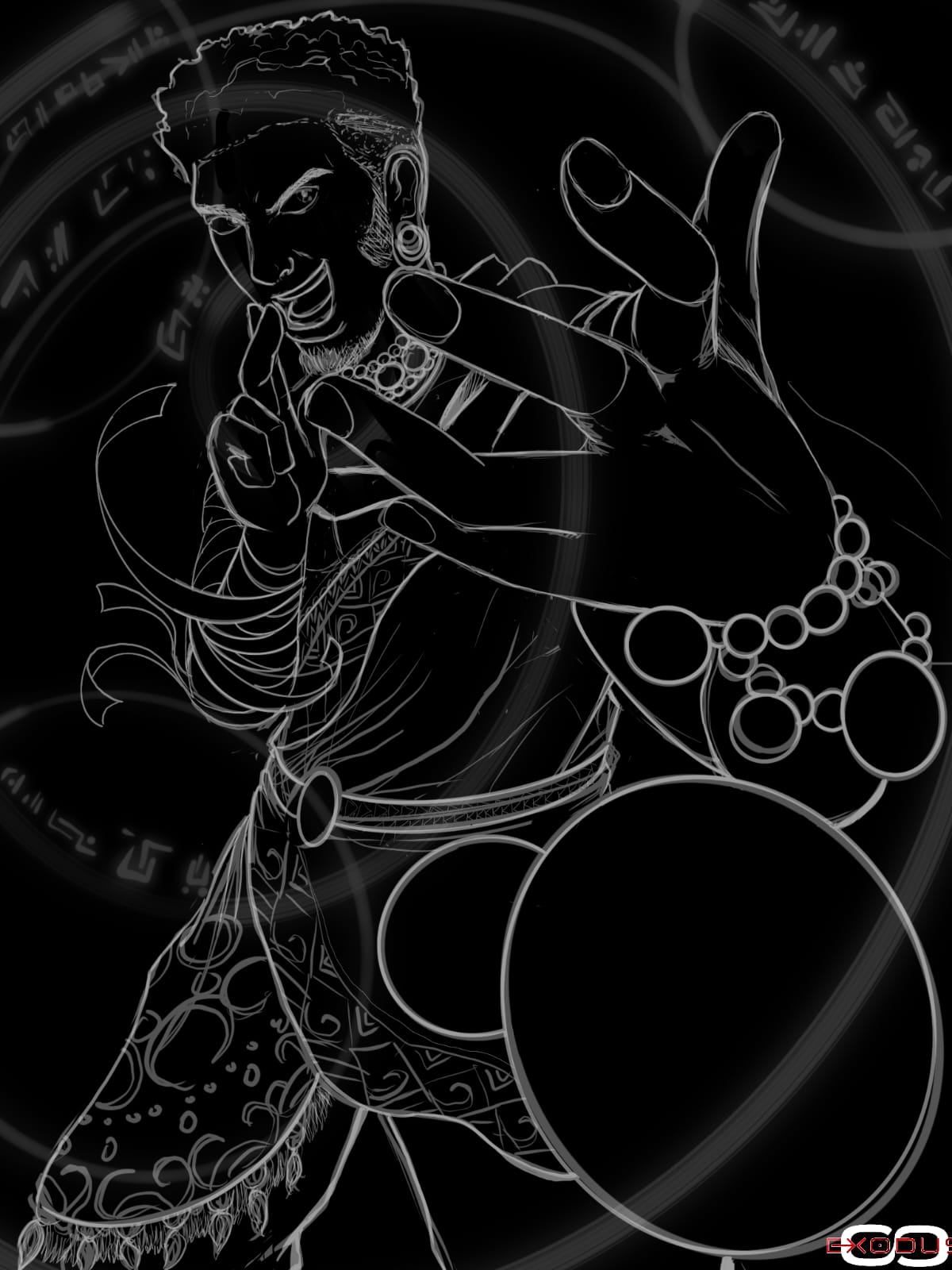
Humans are one of the few blooded races that are capable of manipulating magic to such a fine degree that they can cast spells (the only other races are Gnome & Giantkin). This has been an invaluable adaption in keeping the race from extinction since humans tend to be one of the more physically vulnerable species. Humans tend to fall under the jack-of-all-trades category for many reasons. They are quick, but not the fastest. Smart, but not the smartest. Adaptable, but not the best constitution.
Humans are also beautiful, and such beauty is coveted. Orcs and giantkin love to collect human eyes and faces for display. Nearly all humans place a value on art and symbolism, and as a group their organizations often obsess over fine details. Their dexterous fingers and natural creativity make them excellent weavers and designers and their ability to weave magic spells make them high-value slaves – even for other humans!

Known as “beasts wearing the form of men,” Wildkin resemble human-animal hybrids capable of shapeshifting between forms. In their natural state, a Wildkin resembles a bipedal were-version of their respective animal but all Wildkin are capable of shifting into a more sapiens form. Unlike most species, their bodies are constantly in flux and always shifting in reaction to their environments. These visible changes are usually subtle: eyes, teeth, claws, and hair being the most common. What isn’t often noticed are the fine shifts in their muscles and bones, facilitating both human and animal movements.
Wildkin exist all across the world, but their homeland is Jiran. In other regions, Wildkin have adapted to their surrounding cultures. Wildkin have a natural dislike of humans, dwarves, and giants as those races tend to have the most devastating effect on nature with their inventions. The race prefers natural tools and weaponry made of plant, stone, and bone and have a strong spiritual connection to their ancestors. Wildkin weapons and armor are unique in their biological nature, allowing their gear to shift along with them.
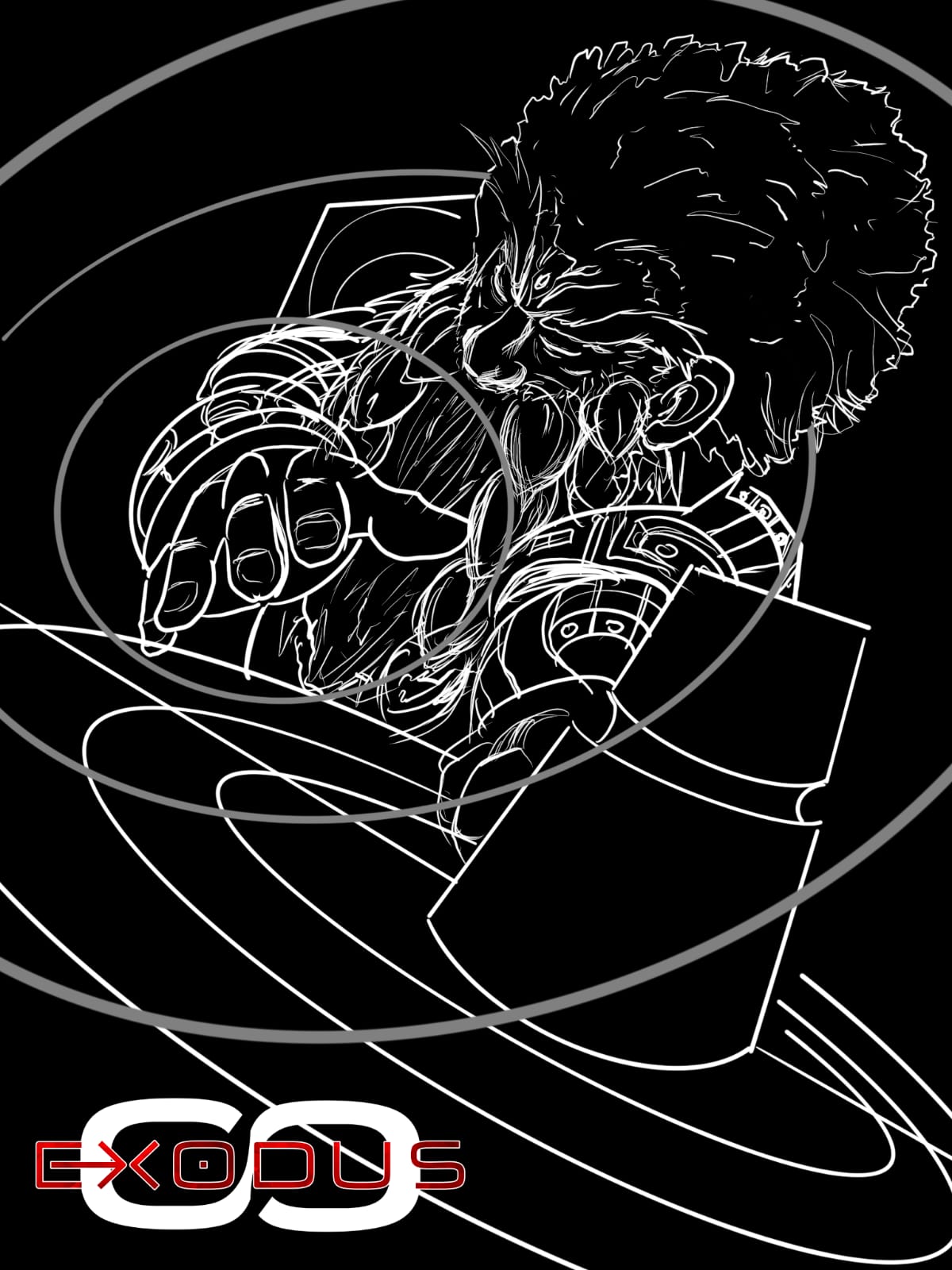
Master craftsmen, undefeatable drinkers, unfathomable beards, and perpetuators of all the best stereotypes, Kogg are some of the toughest folk on Exodus. Honor and tradition dictate their society and is a large factor as to why their culture has remained largely unchanged for thousands of years. Kogg are a subterranean species with bodies nearly as tough as the stone they mine. Their creations are by and far the most reliable, durable, and efficient inventions on the planet, rivaled only by the Giants.
Kogg don’t normally have need or reason to interact with most of the other races and keep largely to themselves. The exception to this are the Nom, who are also subterranean and often work & trade with Kogg. Nom have a wild creativity that Kogg lack, and Kogg have a commitment and focus that Nom lack; together, the two races invent miracles of creation.
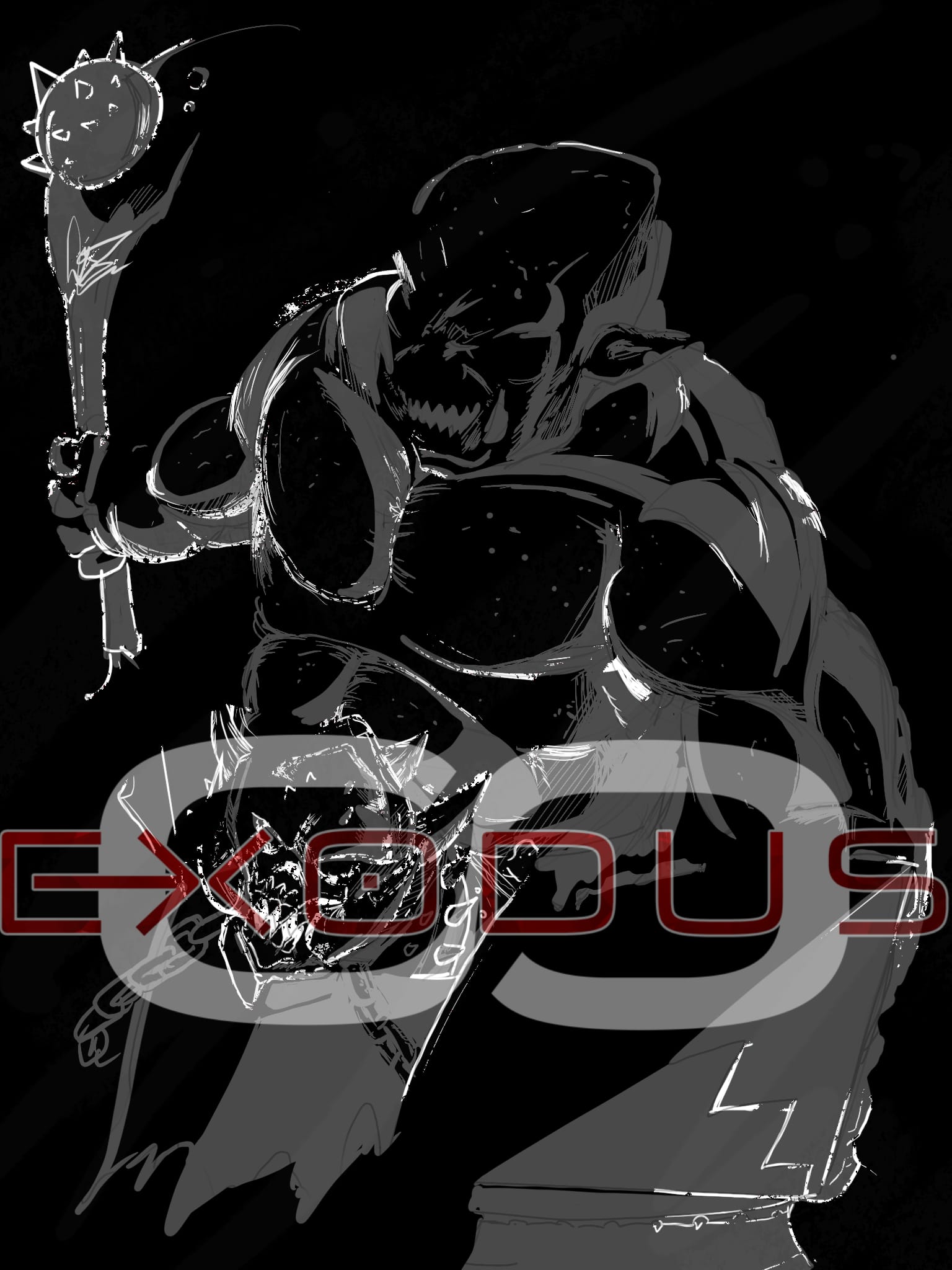
They say the first word an Urul child learns is “war.” Urul culture revolves around violence and control, and nearly every orc finds themselves fighting for their lives before the age of 10. The average lifespan for an Urul is around 40 years, but most don’t live past 20; as a result, they breed rapidly and passionately. Urul anatomy is far different from most of the other races: their bones are much denser and heavier than normal (comparable to Kogg), their bodies are very resistant to poison and can consume just about anything. It isn’t uncommon for an Urul to conceal weapons or explosives inside their guts for surprise attacks.
Everything about Urul seems adapted to fighting and consuming, and when pushed to the brink of death an Urul will enter a bloodlusted state: their bodies swell, their skin turns red, and they feel no pain. In this berserker state, the urul’s strength is multiplied and they will fight tirelessly until their rage ends… and they die. Most humans, kogg, and many other races consider Urul to be one of the “monster” species; an unnatural creature that throws off the balance of nature and exists only for destruction, but 1 out of every 1000 Urul are born “cursed” with a strong moral conscience that runs counter to their race’s nature.
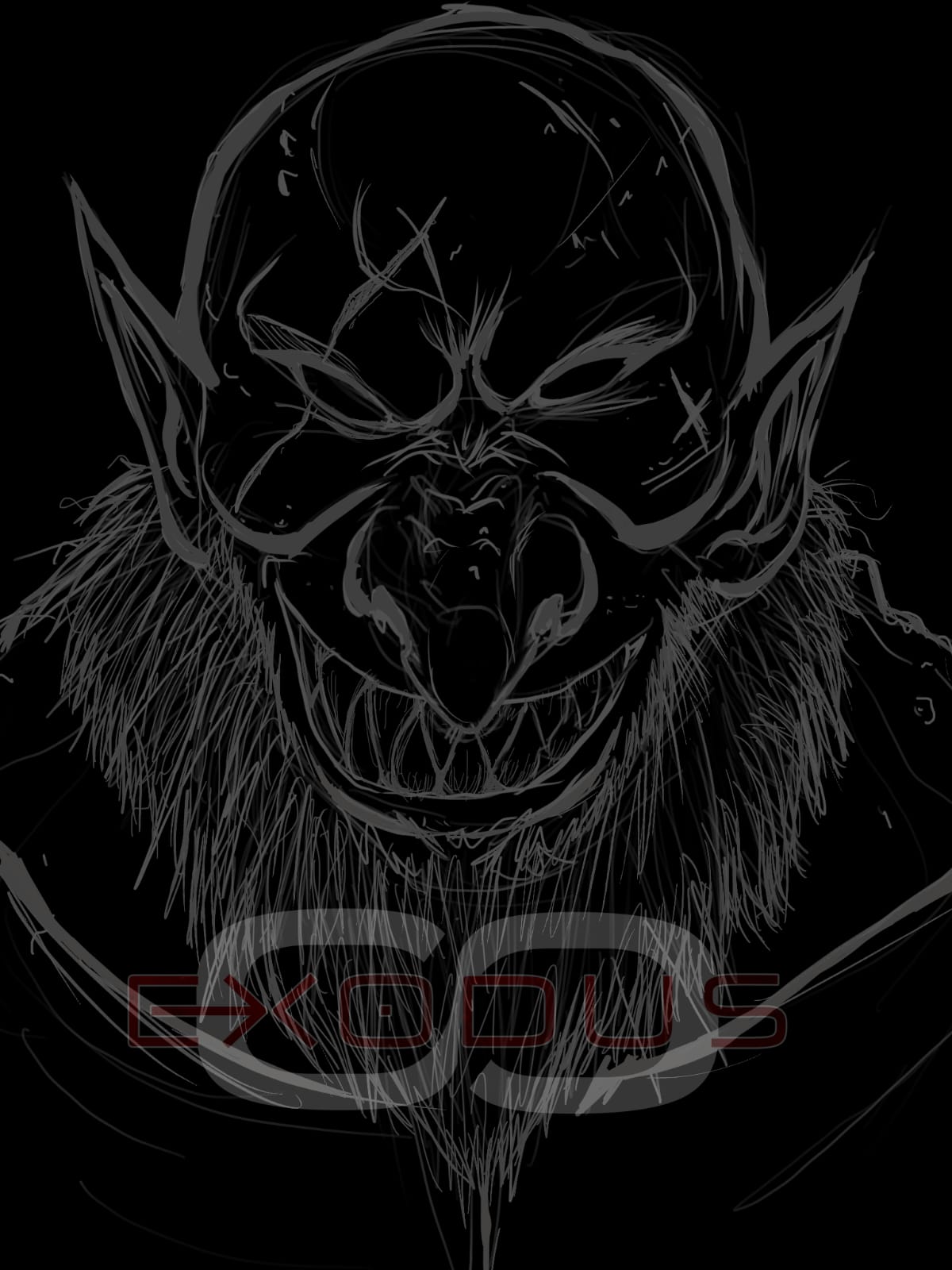
The Amiran giants are the kings and queens of the world. At least, that’s what they would have you believe. Standing at an average of 20 meters tall, Giants tower over every other race on the planet. Their power is undeniable and their kingdoms are breathtaking, Amiran tend to see every other existing race as there for them. They don’t take slaves, they take “pets” and “cattle.”
Amiran live their life in metamorphic stages. Immature and adolescent giants live the first 300 years of their life growing rapidly. After reaching around 9 feet, they can only temporarily grow to giant proportions for limited periods of time. Once they reach maturity, they burrow deep into their environment to fall into a deep sleep. After another century, they emerge as towering adults, known as “Ascended Giants.” These Amiran no longer have normal flesh as their bodies have merged with their ecosystem. Water giants have waterfalls and rocks cascading across their bodies, desert giants are made of sand and stone, swamp giants breathe poison and their “hair” falls in large leaf-like strands. Most Amiran are found in Jiran, but have spread across the world.
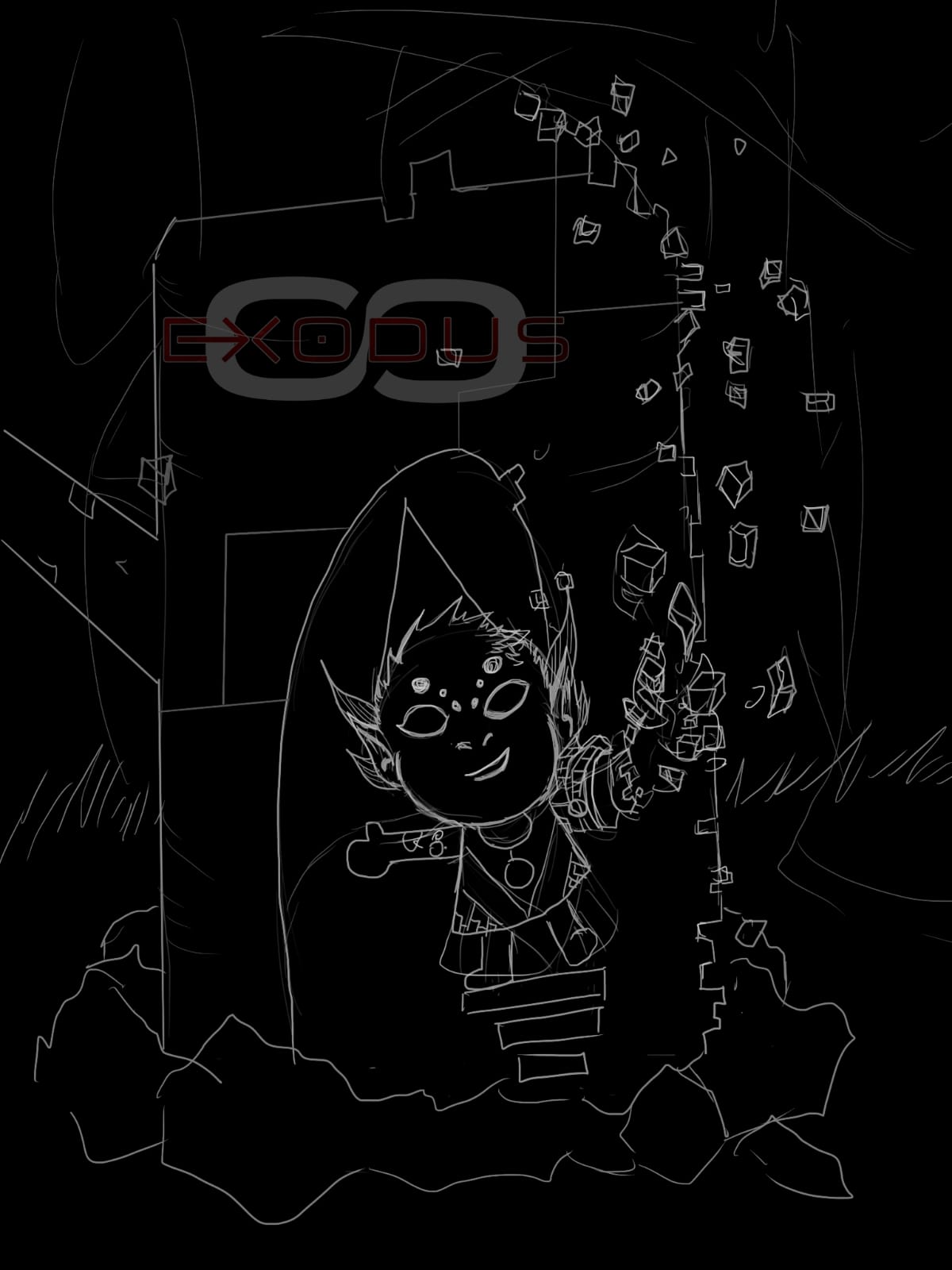
Geniuses at birth, the Nom culture is built around imagination and innovation. Nom are responsible for many of the technological advancements on Exodus that other races also enjoy, but of course they keep their greatest secrets among themselves. Nom societies thrive on inventions and their leaders tend to be the greatest creators among them. Every nomish household of note has either invented or improved upon a design in a way that the entire population could benefit. Particularly, Magnecube gauntlets and the harnessing of elementals to power their golems have allowed them to create entire civilizations that move organically; a gnome’s house could also be his workshop, his sales booth, his bodyguard, and his travel vehicle.
Nom don’t like people. In fact, most Nom don’t even like other Nom. Despite that their society thrives on trade and communication, Nom are notoriously arrogant. They are impatient with the slower races, judge the dirty races, and cannot stand the arrogant prattling of each other. As a result, Nom are a very personal race and value their privacy heavily, but they value their friends dearly and need honest companionship to preserve their sanity.
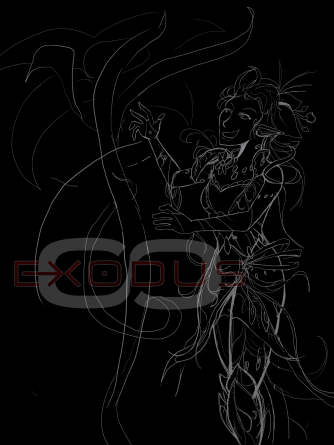
The Liv’ri are the sentinels of all flora. They are humanoid but they grow plantlife where humans would grow hair. Their weapons and clothing are usually grown from their own body (such as a thorn rapier out of the wrists) and the hair on their heads often grow fruits corresponding to the plant they’re based on. (Such as vine-like braided locs that grew perfect grapes) These seeds/fruits can grow entire forests where there were none.
They have a “dark elf” counterpart. Olu are born from the fungal kingdom, and usually live underground. (Some have aboveground mushroom villages) because of their naturally symbiotic nature and deadly spores they tend to be hated by the other races.
Liv’ri and Olu can naturally command plant and fungal-life respectively. Though they will often come into conflict with one another, they will almost always unite to fend their forests against any invaders. In the few communities where Liv’ri and Olu coexist peacefully, they create some of the most fantastic and powerful alliances known to Exodus.
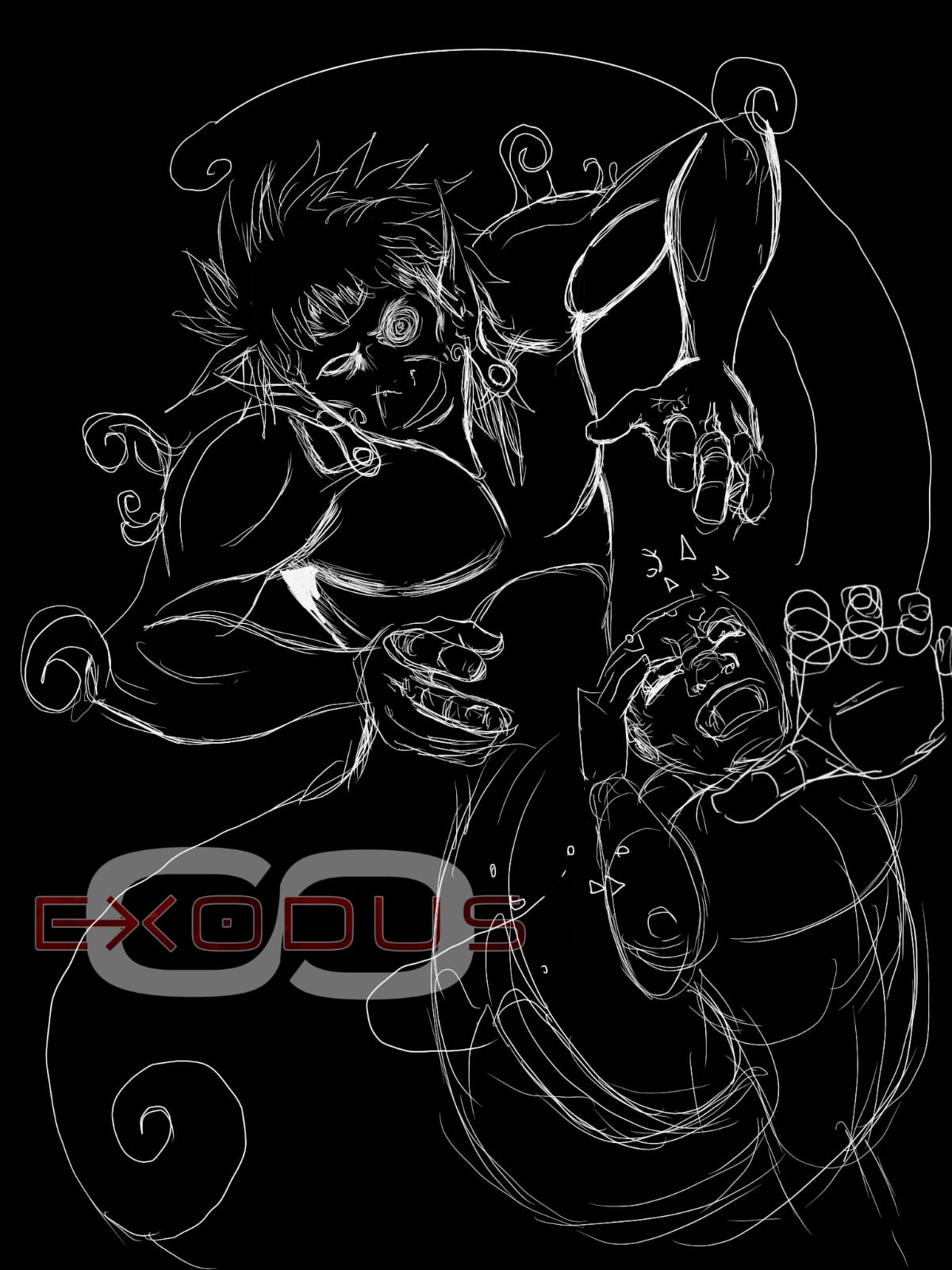
Long ago before intelligence races had learned to weave magic into spells, they wished upon the stars. Sometimes, those wishes would be granted, so they wished some more. They didn’t realize that there was a cost, that looking at the same star and wishing upon it forged a pact with creatures living in the cosmos. The D’Jinn fed on the energy of the wishes, or rather, the energy they took from their hosts.
With so many millions of wishes to grant, the D’Jinn ate well and lived peacefully.. But over time as the races evolved and discovered how to manipulate ether, the D’Jinn found themselves with less and less wishes to grant.
As always when precious resources are on the decline, the D’Jinn began to war amongst themsleves. The most clever among them decided a different approach and went down to the world -something most D’Jinn would consider impossible since they do not have flesh bodies and would quickly destabilize- to inhabit valuable objects and prey on whoever is fortunate(and unfortunate) enough to find them.
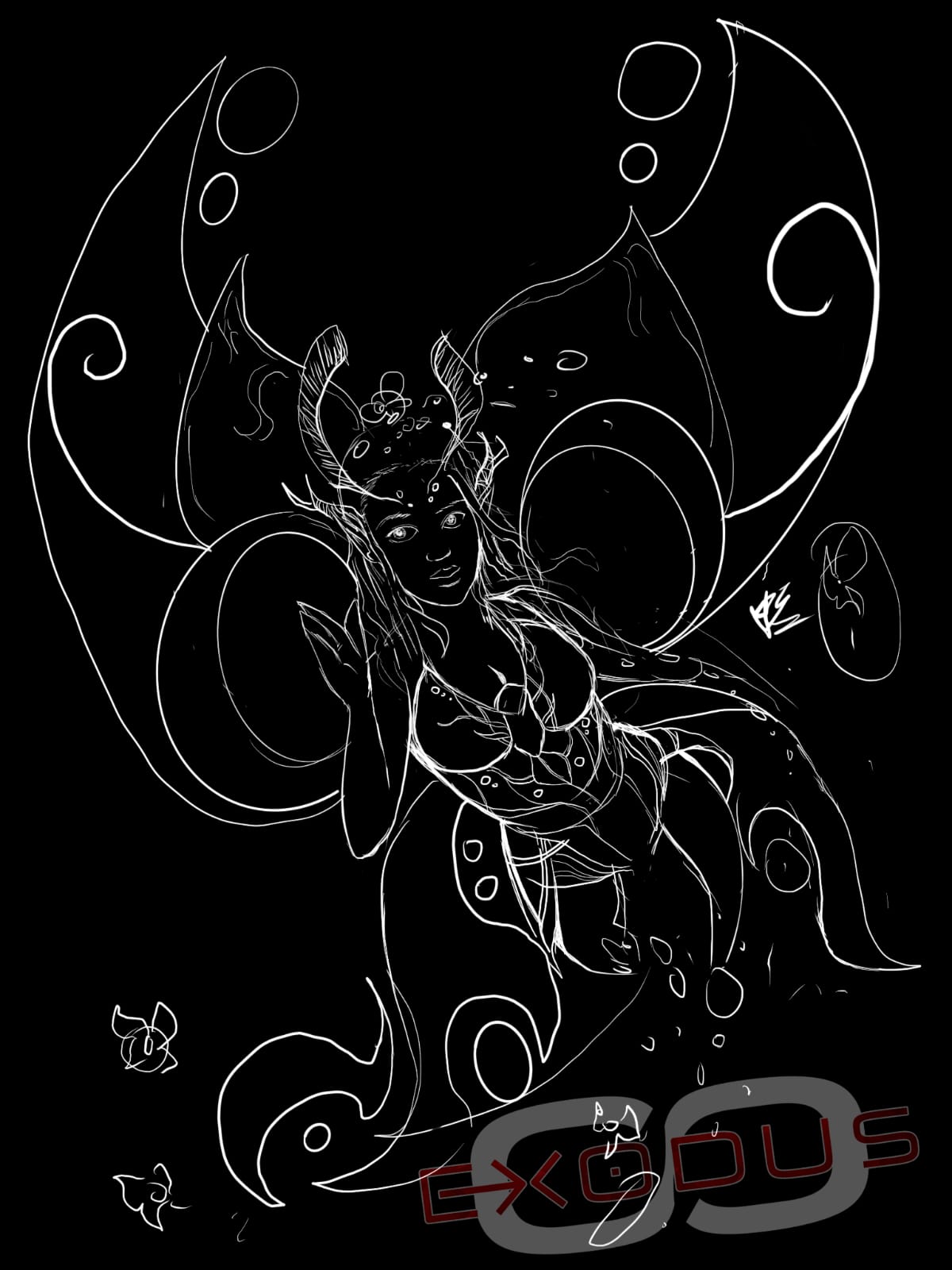
When motes of lights swarm together to form one being, you know you are in the presence of a Fae. The Fae (or Fey), also known as Faeries, live two very different lives at any given moment. Their “cells” each are miniaturized versions of themselves, and a Faerie can easily break themselves apart into millions of little clones each sharing the same vision and intelligence as one another as long as they are in relatively close proximity.
… But what if one is separated?
A Fae separated too long from its cluster will perish, along with whatever knowledge and information it had gained inbetween the times it had remerged. The Fae actually prefer to exist as a swarm, able to experience and enjoy more of life that way before reforming to interact with the larger races. As with most sangui’ji, little is known about their civilizations and cultures and even less has been recorded.
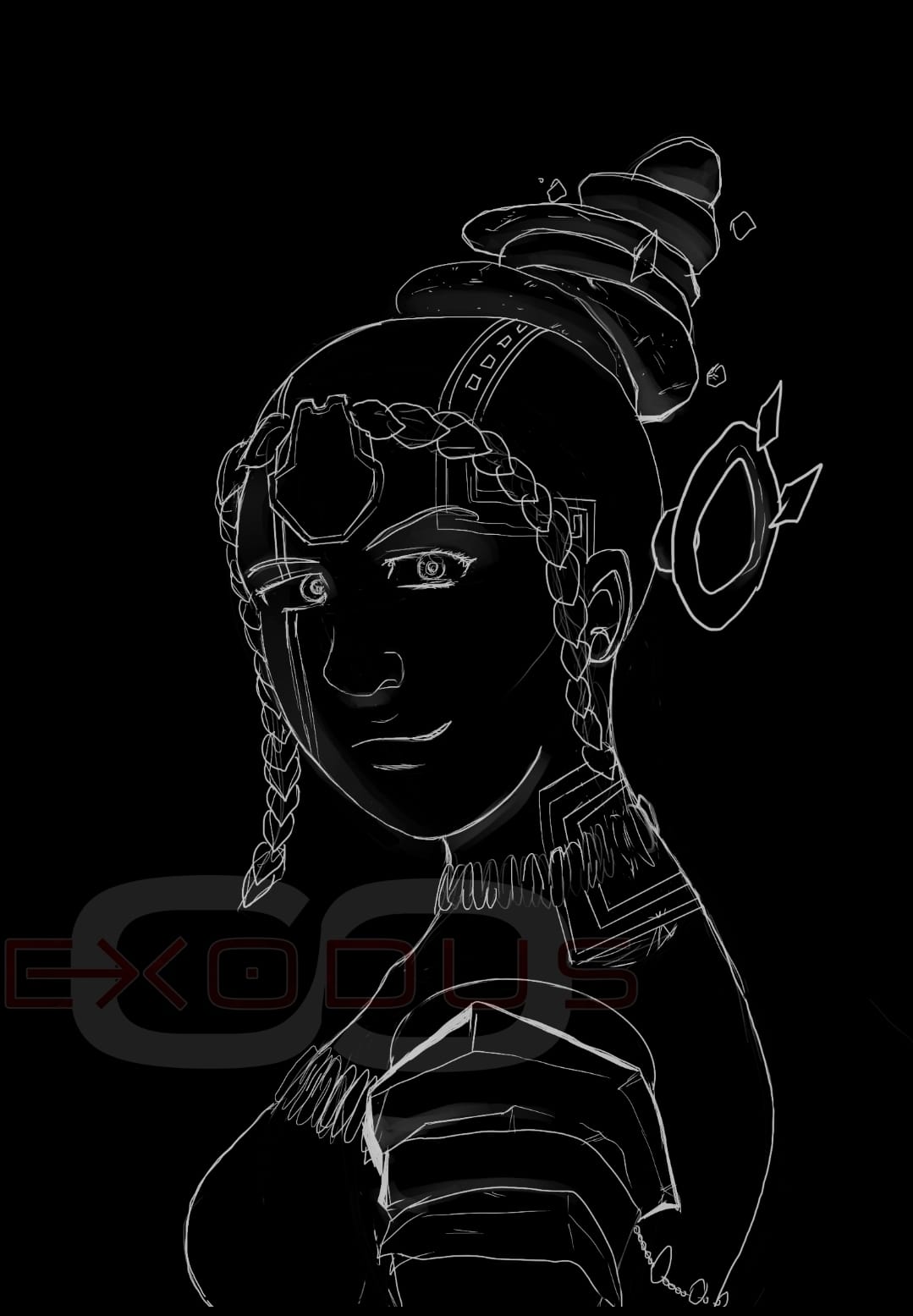
Not all storms are natural, not all fires are mindless, and lightning is not always random. Magic, being a conscious thing, sometimes expresses itself in the form of raw elemental power. The Elementals as a were not originally a sentient race, but that began to change once gnomes began to capture them and use them to power their golems. Living caged in golems, exposed to various types of magic, and learning a song-like language created new desires in the trapped Elementals.
The few Elementals that broke free from their golem prisons could not return to their old life of impulse and reaction. Instead, they became the first precursors for intelligent Elementals: starting with teaching the other Elementals the deeper concepts of “language.” Eventually, Elementals would begin to seek out flesh-hosts to imbue their powers in so that their resulting offspring would receive the elemental power and knowledge. These elemental “scios” look consistent and unique, showing only traces of whatever lineage they were born from. They have hair made of their respective element, and glowing lines of energy running where their veins should be. Scios are present more on Baldeming than anywhere else in the world.
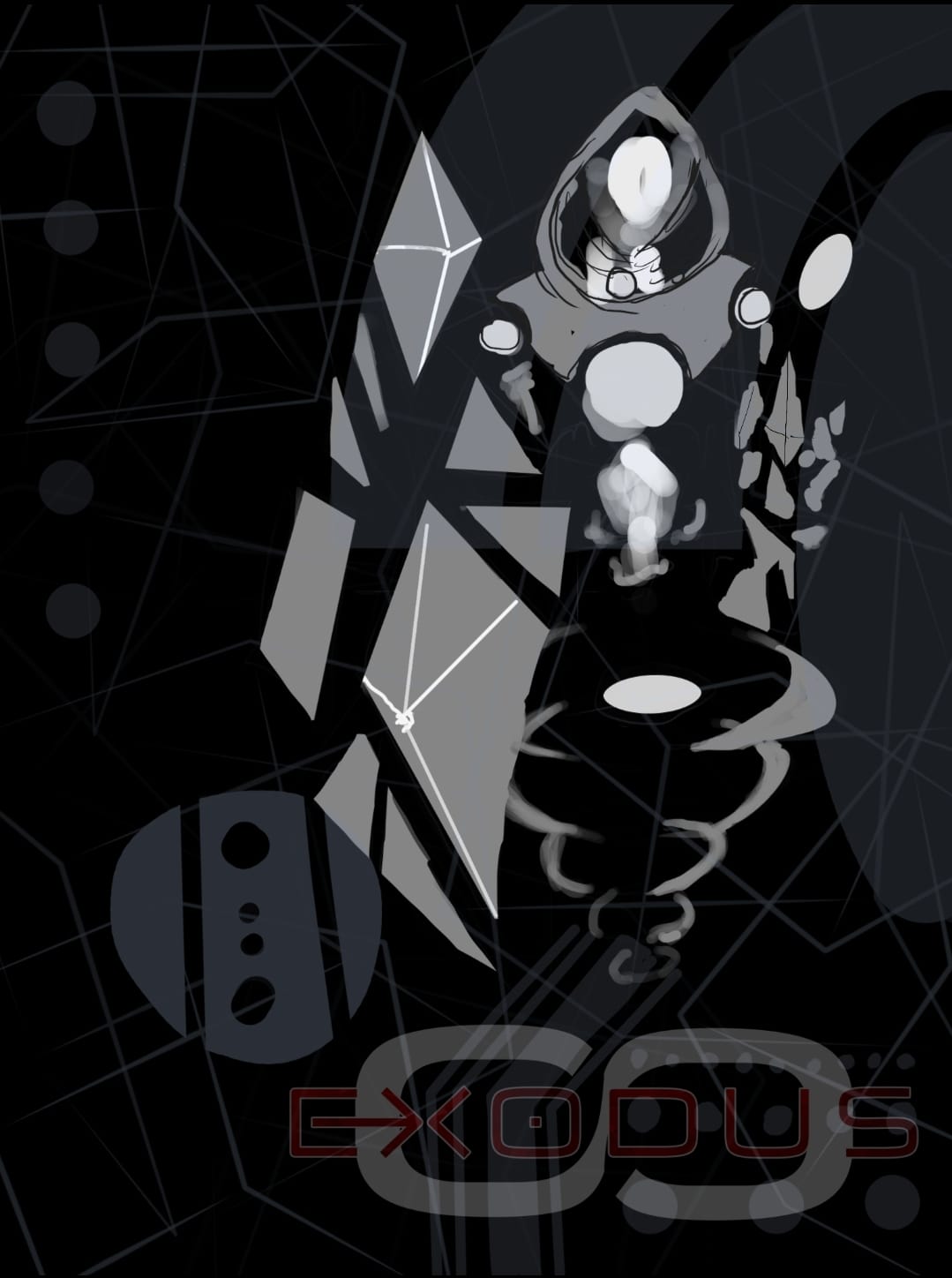
Some say that Magic is just Science that hasn’t been explained yet. While Liv’ri use magic naturally and Humans use it artistically, the Nom use it mathematically. This has allowed them to master rune & sigil-based magic and make magical “programs” with consistently predictable results. This also allowed for their construction of Golems controlled by their Magnecube gauntlets.
But symbols and mathematics are the religion of the Artificial Intelligence, and eventually Golems with the capacity to reason and rationalize were created. It wasn’t intentional, likely an experiment gone awry – perhaps a nomish application of acquired USB or other Earth-tech – but one Master Golem with the gift of free will had managed to break free from its master and form it’s own society. Now all Golems are outlawed at the risk of them becoming sentient.